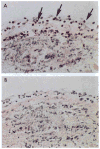Rheumatic fever, autoimmunity, and molecular mimicry: the streptococcal connection
- PMID: 24892819
- PMCID: PMC4669348
- DOI: 10.3109/08830185.2014.917411
Rheumatic fever, autoimmunity, and molecular mimicry: the streptococcal connection
Abstract
The group A streptococcus, Streptococcus pyogenes, and its link to autoimmune sequelae, has acquired a new level of understanding. Studies support the hypothesis that molecular mimicry between the group A streptococcus and heart or brain are important in directing immune responses in rheumatic fever. Rheumatic carditis, Sydenham chorea and a new group of behavioral disorders called pediatric autoimmune neuropsychiatric disorders associated with streptococcal infections are reviewed with consideration of autoantibody and T cell responses and the role of molecular mimicry between the heart, brain and group A streptococcus as well as how immune responses contribute to pathogenic mechanisms in disease. In rheumatic carditis, studies have investigated human monoclonal autoantibodies and T cell clones for their crossreactivity and their mechanisms leading to valve damage in rheumatic heart disease. Although studies of human and animal sera from group A streptococcal diseases or immunization models have been crucial in providing clues to molecular mimicry and its role in the pathogenesis of rheumatic fever, study of human monoclonal autoantibodies have provided important insights into how antibodies against the valve may activate the valve endothelium and lead to T cell infiltration. Passive transfer of anti-streptococcal T cell lines in a rat model of rheumatic carditis illustrates effects of CD4+ T cells on the valve. Although Sydenham chorea has been known as the neurological manifestation of rheumatic fever for decades, the combination of autoimmunity and behavior is a relatively new concept linking brain, behavior and neuropsychiatric disorders with streptococcal infections. In Sydenham chorea, human mAbs and their expression in transgenic mice have linked autoimmunity to central dopamine pathways as well as dopamine receptors and dopaminergic neurons in basal ganglia. Taken together, the studies reviewed provide a basis for understanding streptococcal sequelae and how immune responses against group A streptococci influence autoimmunity and inflammatory responses in the heart and brain.
Keywords: Sydenham chorea; T cells; autoantibodies; autoimmunity; behavior; brain; group A streptococci; rheumatic fever.
Conflict of interest statement
Figures



References
-
- Stollerman GH. Rheumatic and heritable connective tissue diseases of the cardiovascular system. In: Braunmald E, editor. Heart disease: a textbook of cardiovascular medicine. Philadelphia: W.B. Saunders; 1988. pp. 1706–34.
-
- Stollerman GH. Rheumatic Fever. Lancet. 1997;349:935–42. - PubMed
-
- Wannamaker LW. The chain that links the throat to the heart. Circulation. 1973;48:9–18. - PubMed
-
- Jones TD. The diagnosis of rheumatic fever. JAMA. 1944;126:481–4.
-
- Dajani AS. Guidelines for the diagnosis of rheumatic fever (Jones criteria, 1992 update) JAMA. 1992;268:2069–73. - PubMed
Publication types
MeSH terms
Substances
Grants and funding
LinkOut - more resources
Full Text Sources
Other Literature Sources
Medical
Research Materials
